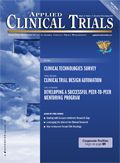On Trial—Europe's Response to Antibiotic Research Gap
Global action and collaboration is needed to tackle the threat of antibiotic-resistant diseases.
Dealing with antibiotic resistance is important—and the subject received lots of attention in November, during different manifestations of the annual antibiotic resistance event around the world. But just as important—and probably more so—is the related question of how to stimulate development of new antibiotics. A workshop at the European Medicines Agency witnessed Andrzej Rys, a senior European Commission official, urge "further action" at policy level in Europe, including making the best use of medicines legislation to bring new antibiotics to patients. In order to do so, it was necessary, he suggested, to bring greater clarity, flexibility and speed to the authorization procedures for the approval of new products, and to look again at the way that the risk-benefit equation is calculated.

At the same meeting, Barry Eisenstein, now head of scientific affairs at Cubist, and a former Lilly research boss, underlined the need for "greater trial feasibility and regulatory predictability." Speaking on behalf of the European drug industry at the EMA meeting, he urged adoption of a tiered approach to authorization that would allow earlier approval for antibiotics.
He pleaded for using the totality of evidence for antibiotic approval and for setting interpretive breakpoints. Suggesting that pharmacodynamics can provide a valuable guide, he contended that if safety is good in Phase I and II, "you probably have a drug." He also called for measures to facilitate small research programs.
Sally Davies, the UK's Chief Medical Officer, has been one of the most vigorous advocates of stimulating antibiotic research, issuing apocalyptic warnings about the need for action. Earlier this year she highlighted a "discovery void" with few new antibiotics developed in the past two decades, leaving the "armory nearly empty as diseases evolve and become resistant to existing drugs."
Davies told this columnist during November that governments around Europe should be more energetic in pushing academia into action, and in promoting collaboration with industry. "Academia on its own doesn't know enough about development paths, so tie-ups with industry are vital," she said. Companies at present do not get engaged because of the lack of incentives, and this has to be dealt with, she insisted. In her view, the public-private partnerships such as the European Innovative Medicines Initiative (IMI) are "a good start." But she also urged examination of other approaches, such as the use of transferable patent vouchers, or even paying more for antibiotics. Within Europe, she said that Sweden and Norway are proving strong allies in the bid to boost research—but that not every European country shares the enthusiasm. "We have work still to do to educate the countries in Eastern Europe," she added.
Meanwhile, the Swedish government allocated nearly $40 million for research on infection and antibiotics over the next four years. Roche said in November that it would resume the development of antimicrobial drugs, while taking over an experimental drug, developed with EU funding, by Polyphor. And IMI has announced plans to conduct clinical trials with innovative anti-infectious agents, using new trial designs, across a new network it has set up of nearly 300 clinical sites across 34 countries.
A broad coalition of national research institutions has put the development of novel antibiotics at the head of the agenda it is now finalizing under a "Joint Program Initiative on Antimicrobial Resistance," which brings together the larger EU member states, along with Canada, Israel, Turkey, and Norway.
In the initiative's scientific advisory board foreward to the draft research agenda, it stresses combining the efforts of the industry, public health bodies, and academic bodies.
In addition to the scientific dimension, "it is essential that regulatory processes are streamlined and economic barriers are lifted to allow the rapid and successful introduction of novel antibiotics and antimicrobials to the market."
Marco Cavaleri, head of anti-infectives and vaccines at the EMA, accepts that regulators could offer advice and liaison "to maximize the chances of regulatory success" for public-private partnerships projects. even though "due to conflict of interest it is not appropriate to take an active part in this kind of initiative."
Peter O'Donnell is a freelance journalist who specializes in European health affairs and is based in Brussels, Belgium.

FDA Fast Tracks Johnson & Johnson’s Nipocalimab for Fetal Neonatal Alloimmune Thrombocytopenia
March 27th 2024Johnson & Johnson is moving forward with a pair of Phase III trials of nipocalimab to reduce the risk of fetal neonatal alloimmune thrombocytopenia in alloimmunized pregnant patients.